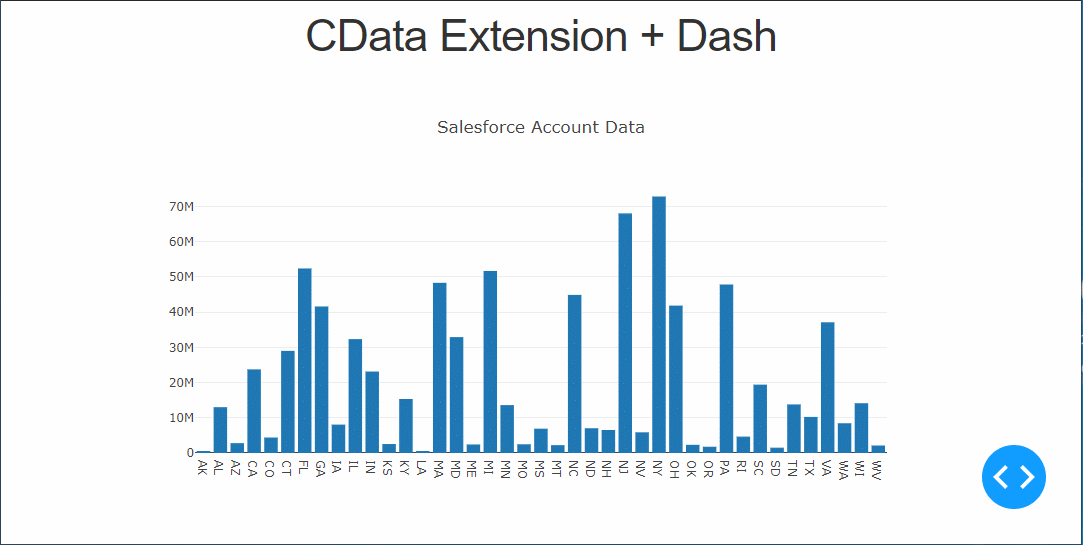Model Context Protocol (MCP) finally gives AI models a way to access the business data needed to make them really useful at work. CData MCP Servers have the depth and performance to make sure AI has access to all of the answers.
Try them now for free →Use Dash to Build to Web Apps on SFTP Data
Create Python applications that use pandas and Dash to build SFTP-connected web apps.
The rich ecosystem of Python modules lets you get to work quickly and integrate your systems more effectively. With the CData Python Connector for SFTP, the pandas module, and the Dash framework, you can build SFTP-connected web applications for SFTP data. This article shows how to connect to SFTP with the CData Connector and use pandas and Dash to build a simple web app for visualizing SFTP data.
With built-in, optimized data processing, the CData Python Connector offers unmatched performance for interacting with live SFTP data in Python. When you issue complex SQL queries from SFTP, the driver pushes supported SQL operations, like filters and aggregations, directly to SFTP and utilizes the embedded SQL engine to process unsupported operations client-side (often SQL functions and JOIN operations).
Connecting to SFTP Data
Connecting to SFTP data looks just like connecting to any relational data source. Create a connection string using the required connection properties. For this article, you will pass the connection string as a parameter to the create_engine function.
SFTP can be used to transfer files to and from SFTP servers using the SFTP Protocol. To connect, specify the RemoteHost;. service uses the User and Password and public key authentication (SSHClientCert). Choose an SSHAuthMode and specify connection values based on your selection.
Set the following connection properties to control the relational view of the file system:
- RemotePath: Set this to the current working directory.
- TableDepth: Set this to control the depth of subfolders to report as views.
- FileRetrievalDepth: Set this to retrieve files recursively and list them in the Root table.
After installing the CData SFTP Connector, follow the procedure below to install the other required modules and start accessing SFTP through Python objects.
Install Required Modules
Use the pip utility to install the required modules and frameworks:
pip install pandas pip install dash pip install dash-daq
Visualize SFTP Data in Python
Once the required modules and frameworks are installed, we are ready to build our web app. Code snippets follow, but the full source code is available at the end of the article.
First, be sure to import the modules (including the CData Connector) with the following:
import os import dash import dash_core_components as dcc import dash_html_components as html import pandas as pd import cdata.sftp as mod import plotly.graph_objs as go
You can now connect with a connection string. Use the connect function for the CData SFTP Connector to create a connection for working with SFTP data.
cnxn = mod.connect("RemoteHost=MyFTPServer;")
Execute SQL to SFTP
Use the read_sql function from pandas to execute any SQL statement and store the result set in a DataFrame.
df = pd.read_sql("SELECT Filesize, Filename FROM MyDirectory WHERE FilePath = '/documents/doc.txt'", cnxn)
Configure the Web App
With the query results stored in a DataFrame, we can begin configuring the web app, assigning a name, stylesheet, and title.
app_name = 'dash-sftpedataplot' external_stylesheets = ['https://codepen.io/chriddyp/pen/bWLwgP.css'] app = dash.Dash(__name__, external_stylesheets=external_stylesheets) app.title = 'CData + Dash'
Configure the Layout
The next step is to create a bar graph based on our SFTP data and configure the app layout.
trace = go.Bar(x=df.Filesize, y=df.Filename, name='Filesize')
app.layout = html.Div(children=[html.H1("CData Extension + Dash", style={'textAlign': 'center'}),
dcc.Graph(
id='example-graph',
figure={
'data': [trace],
'layout':
go.Layout(title='SFTP MyDirectory Data', barmode='stack')
})
], className="container")
Set the App to Run
With the connection, app, and layout configured, we are ready to run the app. The last lines of Python code follow.
if __name__ == '__main__':
app.run_server(debug=True)
Now, use Python to run the web app and a browser to view the SFTP data.
python sftp-dash.py

Free Trial & More Information
Download a free, 30-day trial of the CData Python Connector for SFTP to start building Python apps with connectivity to SFTP data. Reach out to our Support Team if you have any questions.
Full Source Code
import os
import dash
import dash_core_components as dcc
import dash_html_components as html
import pandas as pd
import cdata.sftp as mod
import plotly.graph_objs as go
cnxn = mod.connect("RemoteHost=MyFTPServer;")
df = pd.read_sql("SELECT Filesize, Filename FROM MyDirectory WHERE FilePath = '/documents/doc.txt'", cnxn)
app_name = 'dash-sftpdataplot'
external_stylesheets = ['https://codepen.io/chriddyp/pen/bWLwgP.css']
app = dash.Dash(__name__, external_stylesheets=external_stylesheets)
app.title = 'CData + Dash'
trace = go.Bar(x=df.Filesize, y=df.Filename, name='Filesize')
app.layout = html.Div(children=[html.H1("CData Extension + Dash", style={'textAlign': 'center'}),
dcc.Graph(
id='example-graph',
figure={
'data': [trace],
'layout':
go.Layout(title='SFTP MyDirectory Data', barmode='stack')
})
], className="container")
if __name__ == '__main__':
app.run_server(debug=True)

